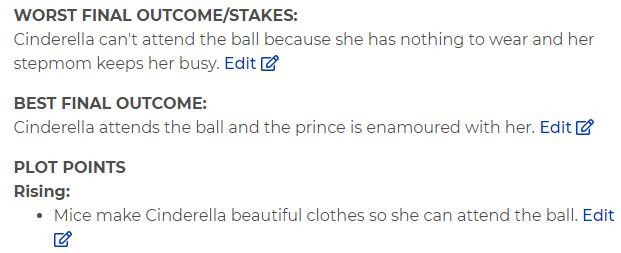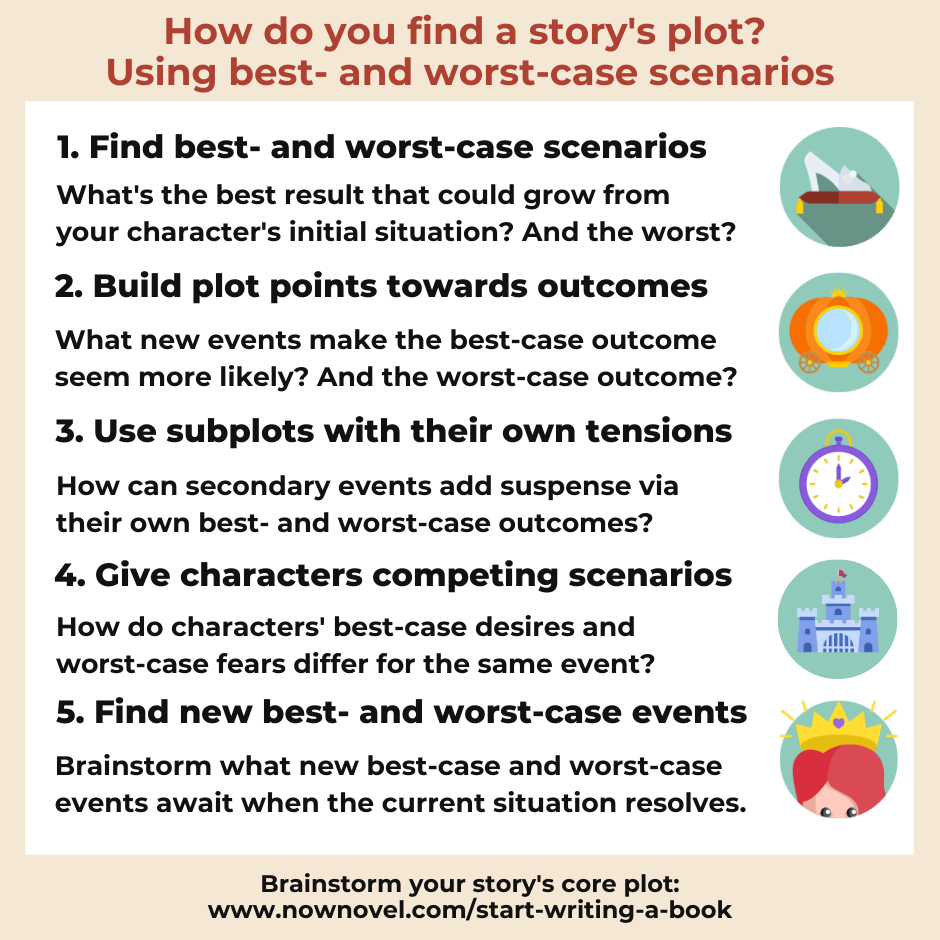How do you find the plot of a story from a broad situation? Brainstorming scenarios - specifically the best- and worst-case outcomes in a given situation - helps to find plot details. To brainstorm a plan for high and low points in characters' arcs, try these tips:
1. Find the best- and worst-case scenario
The 'best-case scenario' in a situation is the best possible outcome.
Let's take this example:
In the fairy tale Cinderella, news arrives that the local Prince will host a ball. Yet Cinderella can't attend for several reasons. For one, she doesn't have the fine clothes to mingle with royalty.
The best-case scenario is that Cinderella somehow is able to attend the ball. The worst-case scenario for this specific event is that she isn't able to go.

In the 'Core Plot' section of the Now Novel story outlining dashboard, brainstorming best-case and worst-case scenarios is a key step. Because once we know the best and worst possible outcome of a situation, we can plan smaller events within a scene. Events that bring either the best-case outcome or the worst-case one closer.
2. Find plot points that build towards outcomes
Once you know the best and worst possible outcomes of a character's situation, you can brainstorm smaller events that lead towards one or the other.
For example, say we're leaning towards Cinderella attending the ball. We could make a list of possible reasons she is able to attend:
- Cinderella sews herself an incredible gown using scraps of fabric she finds on a nearby merchants' trail
- She sneaks a dress from one of her mean stepsisters when they're away
- She receives unexpected help from a stranger who finds her looking despondent in the woods
What if she misses the ball?
We could brainstorm reasons for this turn of events too:
- The ball is called off because the prince has food poisoning
- The ball goes ahead but Cinderella can't go because her stepmother locks her in a broom cupboard
- Cinderella gets the location wrong and journeys to the wrong castle
Some plot points make more sense than others. This is where it's important to connect events building to a best or worst scenario to what's come before.
If we've previously seen the stepmother is cruel and withholding, for example, it makes sense for her being part of the obstacles between Cinderella and the ball. Because we've set this plot development up already. An absurd development such as the prince having food poisoning may work in a spoof, less so in a serious adaptation.
3. Use subplots with their own best and worst-case potential
Once you have an idea of the worst possible outcome and the best possible in a situation, you have an ultimate horizon on either side of your character.
Narrative suspense builds when the story walks a tightrope between the best-case and worst-case outcome. One moment, going to the ball is within reach. The next it's impossible.
New characters and subplots add further complications. In some versions of Cinderella (such as Disney's adaptation), mice help Cinderella to sew a dress.
How do the mice move the story further towards possible outcomes? Perhaps the mice need (and do not have) thread. A subplot could show them attempting to steal thread from Cinderella's stepmother. Yet what if one is caught?
Here is a new, smaller best-case scenario: Mice get thread; Cinderella gets a dress to attend the ball. Yet there are possible worst-case scenarios hidden within this subplot, too (the mice get caught, the thread gets dropped or lost).
The push and pull of rising and falling action that leads towards and away from characters' goals is something to play with. Use it to create dramatic (as well as subtler) turns of events.

4. Give characters competing scenarios
One of the interesting things about best and worst case scenarios is they differ in the same situation between characters.
Take, for example, this starting situation:
News of the prince's ball arrives at Cinderella's cottage in the woods.
Cinderella's best-case scenario might be attending the ball. Yet what is the best outcome for her mean stepmother who's always trying to help Cinderella's stepsisters come out on top?
It could be:
- Make sure the prince notices one of her daughters at the ball
While the worst case could be:
- Cinderella embarrasses her stepmother's pretence of being noble with her guileless, down-to-earth presence
Working out the best-case and worst-case scenario for each character in a shared situation is a useful exercise for finding each character's greatest motivations and fears.
5. Find new best- and worst-case developments
What if your character reaches a situation that is either the best or worst-case scenario you originally planned?
Say, for example, Cinderella get to the ball after all. What is the best-case scenario in this new situation? It could be:
- She has an amazing time and forgets her stepmother's mean, controlling ways
- The prince notices her and asks to dance
- She makes amazing new friends
What about worst-case scenarios? They could include:
- Humiliation/embarrassment (such as tripping on her dress and falling, being subject of slander, rumour or insult)
- Reality falling short of expectations (Cinderella has a miserable time at the ball and feels out of place)
Planning your plot in terms of what would give your characters the greatest progress towards their goals versus what would be most frustrating, painful or uncomfortable will help you to invest each scene with a sense of purpose and direction.
Brainstorm your story's Core Plot now in simple, easy steps and create a detailed story outline.










Absolutely! Here's a sample of my series: https://www.martacweeks.com/2019/11/in-thick-of-it-beware-contains-adult.html
Marta - About 6 years ago
Thanks for sharing that, Marta.
Jordan At Now Novel - About 6 years ago
Thanks 👍
Fedelyn Dry - Over 2 years ago
It's a pleasure, Fedelyn. Thanks for reading our blog and sharing your feedback.
Jordan - Over 2 years ago